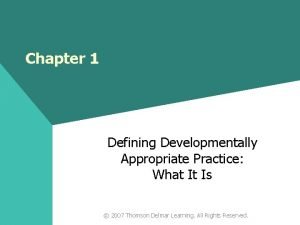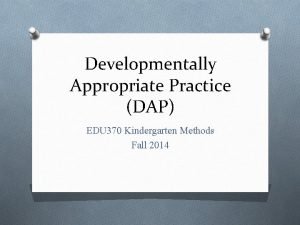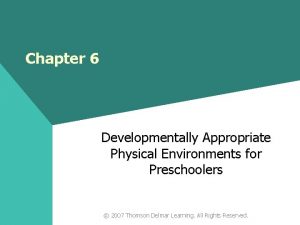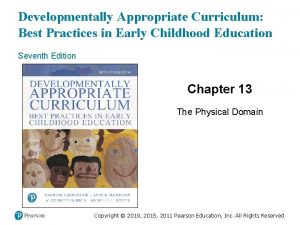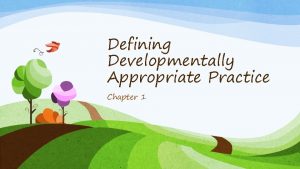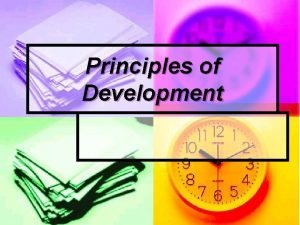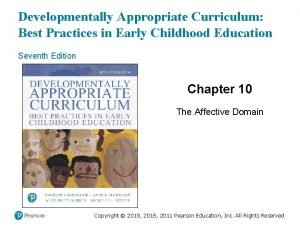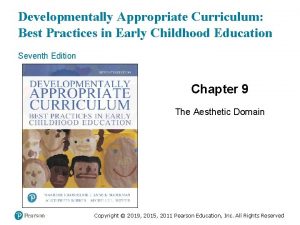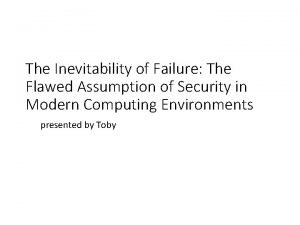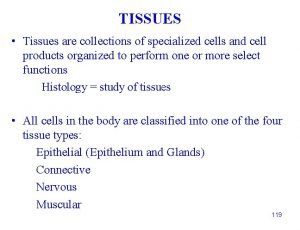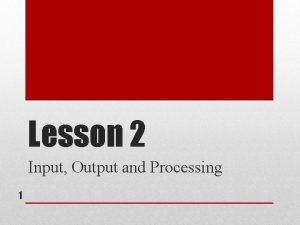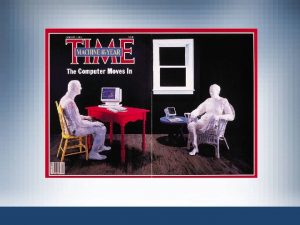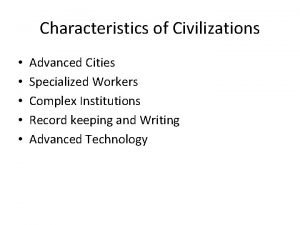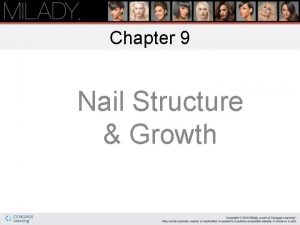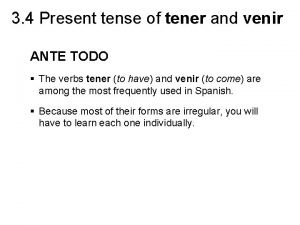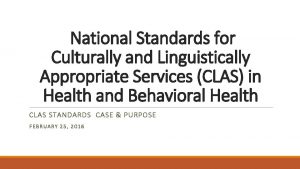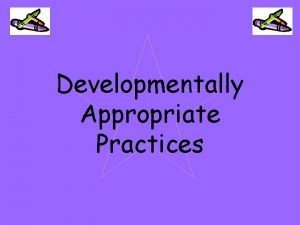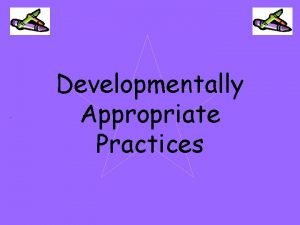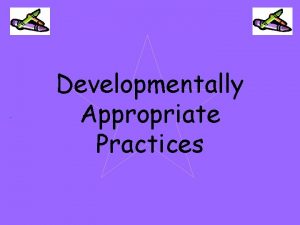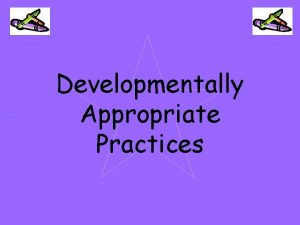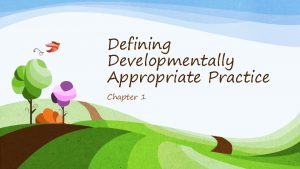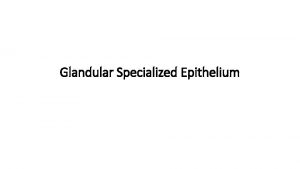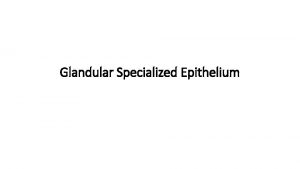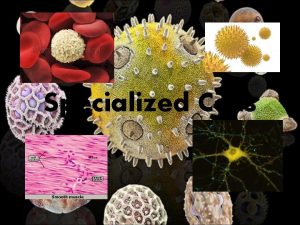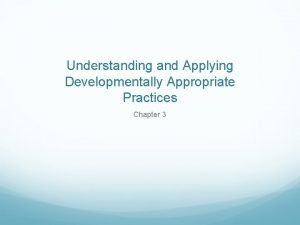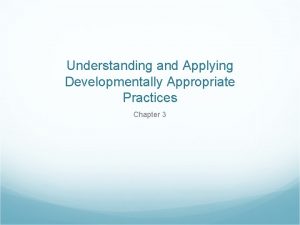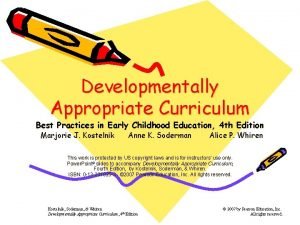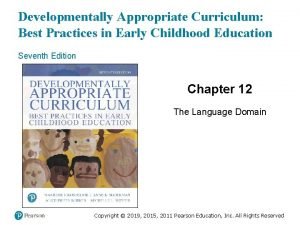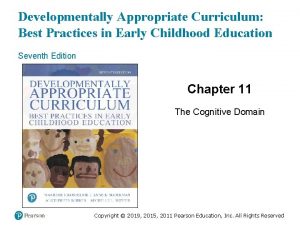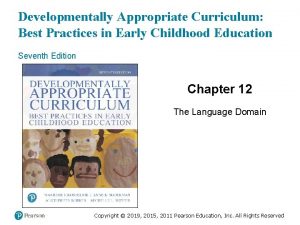Developmentally appropriate practices and specialized instruction are fundamentally





















- Slides: 21

Developmentally appropriate practices and specialized instruction are fundamentally dependent upon each other in early childhood special education. • • Record 2 thoughts you have about this statement. Record 1 question / wondering you have about this statement.

Big Ideas • Developmentally appropriate practices and specialized instruction are fundamentally dependent upon each other in early childhood special education. • Not an either / or • It is possible to have specialized instruction and DAP • Quality early childhood settings have children with a variety of special needs meaningfully participating. • We often encounter barriers when we do not understand the meaning behind the language we use.

Guidelines for DAP Global quality indicators Individualization Specialized instruction

Guidelines for Developmentally Appropriate Practice • Creating a caring community of learners • Teaching to enhance development and learning • Planning curriculum to achieve important goals • Assessing children’s development and learning • Establishing reciprocal relationships with families Copple & Bredekamp, 2009

Teaching to enhance development and learning PQA items Possible adaptations, scaffolding DEC Recommended Instructional Practice

Teaching to enhance development and learning • Teachers plan for learning experiences that effectively implement a comprehensive curriculum so that children attain key goals across the domains.

PQA Items • IV – A - Curriculum model • IV – B – Team teaching • IV – D – Anecdotal notes taking by staff

DEC Recommended Practices • INS 2. Practitioners, with the family, identify skills to target for instruction that help a child become adaptive, competent, socially connected, and engaged and that promote learning in natural and inclusive environments.

Teaching to enhance development and learning • Teachers plan environment, schedule, and daily activities to promote each child’s learning and development.

PQA Items • I – Learning Environment A- Safe and healthy environment B- Defined interest areas C- Logically located interest areas D- Outdoor space, equipment, materials E- Organization and labeling of materials F- Varied and open-ended materials G- Plentiful materials H- Diversity-related materials

PQA Items • II – Daily Routine A- Consistent daily routine B- Parts of the day C- Appropriate time for each part of the day D- Time for child planning E- Time for child-initiated activities F- Time for child recall G- Small-group time H- Large-group time I- Choices during transition times L- Outside time

DEC Recommended Practices • E 3. Practitioners work with the family and other adults to modify and adapt the physical, social, and temporal environments to promote each child’s access to and participation in learning experiences.

Teaching to enhance development and learning • Teachers possess an extensive repertoire of skills and strategies, they are able to draw on, and they know how and when to choose them, to effectively promote each child’s learning and development at that moment. Those skills include the ability to adapt curriculum, activities, and materials to ensure full participation of all children. Those strategies include but are not limited to acknowledging, encouraging, giving specific feedback, modeling, demonstrating, adding challenge, giving cues or other assistance, providing information, and giving directions.

PQA Items • III- Adult Child Interaction D- Support for child communication F- Adults as partners in play G- Encouragement of child initiatives H- Support for child learning at group times I- Opportunities for child exploration J- Acknowledgment of child efforts L- Independent problem solving M- Conflict Resolution

DEC Recommended Practices • INS 2. Practitioners, with the family, identify skills to target for instruction that help a child become adaptive, competent, socially connected, and engaged and that promote learning in natural and inclusive environments. • INS 7. Practitioners use explicit feedback and consequences to increase child engagement, play, and skills.

Teaching to enhance development and learning • Teachers know how and when to scaffold children’s learning and just enough assistance to enable each child to perform at a skill level just beyond what the child can do on their own. • Teachers make experiences in their classroom accessible and responsive to all children and their needs.

Scaffolding • Silence • Observation • Understanding • Listening • Entering activity • Participating on child’s developmental level and interest • Offering support • Providing gentle extensions within context, as appropriate

DEC Recommended Practice • INS 6. Practitioners use systematic instructional strategies with fidelity to teach skills and to promote child engagement and learning. • Example: Incidental Teaching

Identify why you are stuck. What is your position? How is this a disconnect or problem? How does the current curriculum support your anticipated outcome? Do you need something “more? ” How do these techniques align with components of high quality early childhood practices? Which of these techniques are a good fit for the child, classroom, and situation? What do you hope to achieve? Why do you hold this position? Why do you want to do what you want to do? What additional techniques are supported as Recommended, Evidence-based, or Research-based practices? Specialized Instruction 1. Use of appealing open-ended appropriate materials 2. Manipulation of materials AND ideas 3. Children make choices 4. Encourage child language and thought 5. Adults scaffold children’s thinking

Developmentally appropriate practices and specialized instruction are fundamentally dependent upon each other in early childhood special education. • • Record 2 thoughts you have about this statement. Record 1 question / wondering you have about this statement.

Turn and Talk • How are your responses similar to those at the beginning of the session? • How are they different? • What do you want to explore further? • How might you do so?
 Developmentally appropriate practice definition
Developmentally appropriate practice definition Mikael ferm
Mikael ferm 10 effective dap teaching strategies
10 effective dap teaching strategies Developmentally appropriate environment
Developmentally appropriate environment Developmentally appropriate curriculum 7th edition
Developmentally appropriate curriculum 7th edition Define developmentally appropriate practice
Define developmentally appropriate practice Development occurs in a relatively orderly sequence
Development occurs in a relatively orderly sequence Developmentally appropriate curriculum 7th edition
Developmentally appropriate curriculum 7th edition Developmentally appropriate curriculum 7th edition
Developmentally appropriate curriculum 7th edition Flawed assumption meaning
Flawed assumption meaning Fundamentally toys
Fundamentally toys Differentiated instruction vs individualized instruction
Differentiated instruction vs individualized instruction Direct instruction strategies
Direct instruction strategies Collection of specialized cells and cell products
Collection of specialized cells and cell products Specialized input device
Specialized input device Knowledge management and specialized information systems
Knowledge management and specialized information systems Specialized workers characteristics
Specialized workers characteristics Chapter 9 nail structure and growth review questions
Chapter 9 nail structure and growth review questions Intentalo provide the appropriate forms of tener and venir
Intentalo provide the appropriate forms of tener and venir National culturally and linguistically appropriate services
National culturally and linguistically appropriate services Specialised connective tissues
Specialised connective tissues What is the function of stems?
What is the function of stems?
